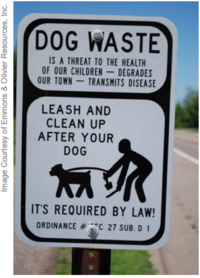
In water quality monitoring, specific disease-producing (pathogenic) organisms are not easily identified. Testing for them is difficult, expensive, and time-consuming. Instead, fecal coliforms and Escherichia coli (E. coli), two closely related bacteria groups, can indicate the presence of pathogens. Fecal coliform and E. coli found in Minnesota rivers and streams may come from human, pet, livestock, and wildlife waste and are more common in heavily populated or farmed areas. Bacteria may reach surface water through malfunctioning or illicit septic system connections, urban stormwater, manure spills or runoff, and more (Minnesota Pollution Control Agency website, accessed January 25, 2018).
Below are links to pages in this manual that address bacteria in stormwater runoff.
- Overview and management strategies for bacteria in stormwater
- Guidance for meeting bacteria TMDL MS4 permit requirements
- Checklist for bacteria source inventory
- Support document for Checklist for bacteria source inventory
References
- Bannerman, R.T., Owens, D.W., Dodds, R.B., and Hornewer, N.J.. 1993. Sources of pollutants in Wisconsin stormwater. Water Science Technology, v. 28, no. 3-5, p. 241–259.
- Burnhart, Matt, (undated). Sources of bacteria in Wisconsin stormwater: Madison, WI. Wisconsin Department of Natural Resources. 34 p.
- Law, N.L., DiBlasi, K., and U. Ghosh 2008. Deriving Reliable Pollutant Removal Rates for Municipal Street Sweeping and Storm Drain Cleanout Programs in the Chesapeake Bay Basin. Center for Watershed Protection.
- McLellan, S.L., E. Jensen Hollis. 2006. Bacteria Sources and Fate Report. Bacteria Source, Transport and Fate Study - Phase 1, Volume 3.122 p.
- Sartor, J.D., and Gaboury, D.R.. 1984. Street sweeping as a pollution control measure—Lessons learned over the past ten years. Science of the Total Environment. v. 33, p. 171–183.
- Sawyer, C.B., J.C. Hayes, and W.R. English. 2010. Characterization of Escherichia Coli for Sediment Basin Systems at Construction Sites. World Environmental and Water Resources Congress 2010, May 16-20, 2010 | Providence, Rhode Island, United States.
- Schueler, T. 2000. Microbes and Urban Watersheds: Concentrations, Sources, & Pathways. Watershed Protection Techniques. 3(1): 554-565
- Selbig, W.R. and R. T. Bannerman. 2007. Evaluation of Street Sweeping as a Stormwater-Quality-Management Tool in Three Residential Basins in Madison, Wisconsin. USGS Scientific Investigations Report 2007–5156.
- A. Selvakumar, and M. Borst. 2006. Variation of microorganism concentrations in urban stormwater runoff with land use and seasons. J Water Health, 4, 109-124.
- Sutherland, R. 2011. Street Sweeping 101. Stormwater. January-February 2011.
- Tiefenthaler, L., E. D. Stein, and K.C. Schiff. 2011. Levels and patterns of fecal indicator bacteria in stormwater runoff from homogenous land use sites and urban watersheds. Journal of Water and Health. Vol 09.2:279-290.
- United States Geological Survey. 1998. Urban Stormwater Quality, Event-Mean Concentrations, and Estimates of Stormwater Pollutant Loads, Dallas-Fort Worth Area, Texas, 1992–93. Water-Resources Investigations Report 98-4158.
- Urban Water Research Council. 2014. Pathogens in Urban Stormwater Systems. UWRRC Technical Committee Report. 289 p.
- Waschbusch, R.J., Selbig, W.R., and Bannerman, R.T.. 1999. Sources of phosphorus from two urban residential basins in Madison, Wisconsin, 1994–95. U.S. Geological Survey Water-Resources Investigations Report 99-4021, 47 p.
- Wu, J., S. C. Long, D. Das, and S. M. Dorner. 2011. Are microbial indicators and pathogens correlated? A statistical analysis of 40 years of research. Journal of Water and Health. 09.2:265-278.
- Zarriello, P. J., R. F. Breault, and P. K. Weiskel. 2002. Potential Effects of Structural Controls and Street Sweeping on Stormwater Loads to the Lower Charles River, Massachusetts. Water-Resources Investigations Report 02-4220. 50 p.
This page was last edited on 27 December 2022, at 19:36.
